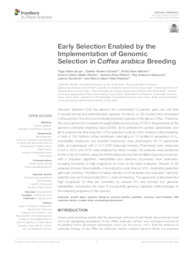Early Selection Enabled by the Implementation of Genomic Selection in Coffea arabica Breeding.
Early Selection Enabled by the Implementation of Genomic Selection in Coffea arabica Breeding.
Author(s): SOUSA, T. V.; CAIXETA, E. T.; ALKIMIM, E. R.; OLIVEIRA, A. C. B. de; PEREIRA, A. A.; SAKIYAMA, N. S.; ZAMBOLIM, L.; RESENDE, M. D. V. de
Summary: Genomic Selection (GS) has allowed the maximization of genetic gains per unit time in several annual and perennial plant species. However, no GS studies have addressed Coffea arabica, the most economically important species of the genus Coffea. Therefore, this study aimed (i) to evaluate the applicability and accuracy of GS in the prediction of the genomic estimated breeding value (GEBV); (ii) to estimate the genetic parameters; and (iii) to evaluate the time reduction of the selection cycle by GS in Arabica coffee breeding. A total of 195 Arabica coffee individuals, belonging to 13 families in generation of F2, susceptible backcross and resistant backcross, were phenotyped for 18 agronomic traits, and genotyped with 21,211 SNP molecular markers. Phenotypic data, measured in 2014, 2015, and 2016, were analyzed by mixed models. GS analyses were performed by the G-BLUPmethod, using the RKHS (Reproducing Kernel Hilbert Spaces) procedure, with a Bayesian algorithm. Heritabilities and selective accuracies were estimated, revealing moderate to high magnitude for most of the traits evaluated. Results of GS analyses showed the possibility of reducing the cycle time by 50%, maximizing selection gains per unit time. The effect of marker density on GS analyses was evaluated. Genomic selection proved to be promising for C. arabica breeding. The agronomic traits presented high complexity for they are controlled by several QTL and showed low genomic heritabilities, evidencing the need to incorporate genomic selection methodologies to the breeding programs of this species.
Publication year: 2019
Types of publication: Journal article
Unit: Embrapa Coffee
Observation
Some of Embrapa's publications are published as ePub files. To read them, use or download one of the following free software options to your computer or mobile device. Android: Google Play Books; IOS: iBooks; Windows and Linux: Calibre.
Access other publications
Access the Agricultural Research Database (BDPA) to consult Embrapa's full library collection and records.
Visit Embrapa Bookstore to purchase books and other publications sold by Embrapa.

